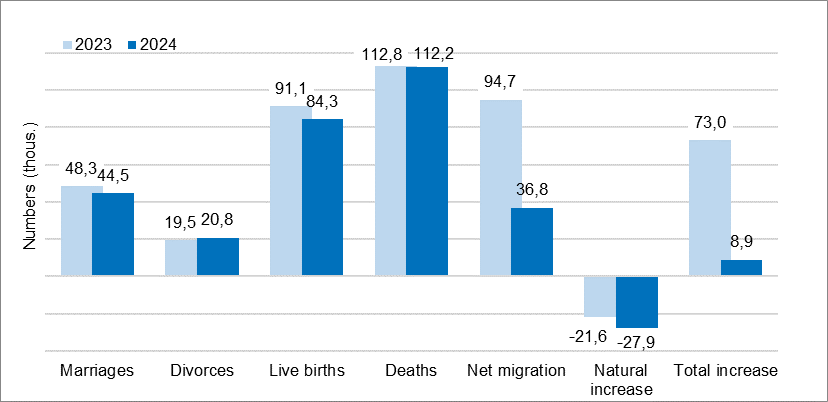2025-04-15
indicators

The population of the Czech Republic increased by 8,900 people in 2024, reaching 10,909,500 by the end of the year. This growth was driven by international migration, which added 36,800 residents, while the country continued to experience natural population decline for the sixth consecutive year. The natural decrease, caused by the number of deaths exceeding the number of births, amounted to 27,900. The total number of deaths reached 112,200, a slight decrease from the previous year. However, the most notable demographic shift was a significant drop in the number of births. In 2024, there were 84,311 live births — the lowest annual figure ever recorded in the Czech Republic, surpassing the previous low from 1999. This marked the third consecutive year of decline, with births down 8% from 2023. The decline affected all birth orders, including first-borns (down 9%), second-borns (down 7%), and third or higher-order births (down 5%). The fertility rate fell to 1.37 children per woman, a decrease from the previous year, and 47% of children were born outside of marriage. Deaths remained concentrated among older age groups, with the largest numbers occurring among those aged 75–84. January and December saw the highest monthly death totals, while June had the fewest. Life expectancy continued to improve modestly, with a slight year-on-year increase for both men and women. Marriage rates declined for the second year in a row. In 2024, 44,500 couples were married, a drop of 3,800 or 8% from the previous year. The decline was evident across all age groups between 25 and 50. The most common age for marriage was among those born in 1993. Meanwhile, divorces increased, with 20,800 couples separating, up 7% from the previous year. The total divorce rate rose slightly to 40%, with most divorces occurring after 4 to 7 years of marriage. More than half of these divorces involved minor children, affecting a total of 19,300 children. International migration remained the main source of population growth. While the number of immigrants decreased by 19,400 compared to 2023, the total still reached 121,800—significantly higher than pre-war levels. The number of people leaving the country increased sharply, with nearly 85,000 registered emigrants, up 38,400 from the previous year. A large proportion of these were individuals whose temporary protection had expired. Despite a slight overall population increase, the demographic trends in 2024 reflect continued challenges for the Czech Republic, including declining birth rates, an ageing population, and a reliance on migration to offset natural population losses. Source: CSO

